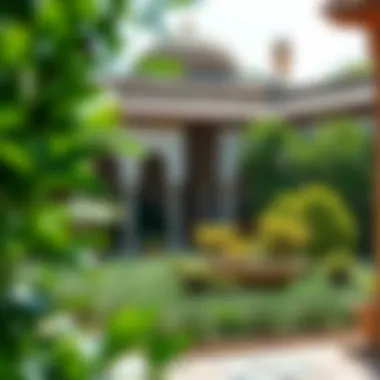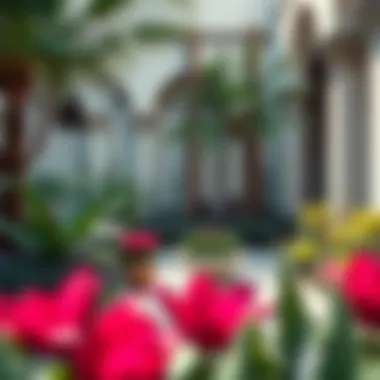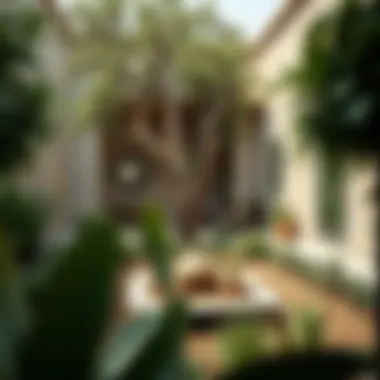Exploring the Islamic Garden: Culture and History


Intro
The concept of the Islamic garden is much more than a mere horticultural endeavor; it encapsulates diverse historical narratives and cultural expressions that have evolved through centuries. In a world where urban landscapes often overshadow natural beauty, the Islamic garden serves as a reminder of man's quest for harmony with nature and spirituality. Understanding these gardens requires an exploration of their design elements, symbolism, and the philosophical ideals they embody. This article aims to provide an extensive look at these gardens, revealing how they have shaped landscapes within Islamic civilization and continue to influence modern urban environments.
By delving into the rich heritage of the Islamic garden, we will highlight key points, including their historical significance and cultural meanings rooted in Islamic tradition. We will also examine various examples throughout history, from the famed gardens of Persia to contemporary interpretations that continue to resonate with today's society. In this journey, we aim to not just inform but to enlighten, offering fresh perspectives that challenge conventional views on the intersection of nature and culture in Islamic context.
Prolusion to Islamic Gardens
The world of Islamic gardens is not just a collection of plants, water features, and pathways; it represents a tapestry of history, culture, and spirituality intertwined. Concepts surrounding the Islamic garden have evolved over centuries, acting as a mirror reflecting the society, values, and ideals of the people who cultivated them.
Understanding the significance of Islamic gardens offers profound insights into Islamic civilization itself. These gardens were spaces where nature and art collided, emphasizing serenity, beauty, and harmony. The very essence of their design is steeped in meaning; representing more than just a retreat from the bustling world, they symbolize an aspiration towards paradise and divine beauty.
As we dive deeper into this topic, it becomes clear that these gardens have played pivotal roles in various facets of culture—spiritual, social, even political. It's essential to highlight that Islamic gardens are deliberately structured to foster contemplation and tranquility. Every element within these gardens serves a purpose, echoing philosophical ideals cherished throughout history.
With this understanding, we can explore further and uncover the intricate tapestry of meanings woven into the fabric of Islamic gardens. Each flower, stone, and watercourse tells a story that resonates with the ancient and modern alike, showcasing the garden's role as a bridge between past traditions and contemporary interpretations.
Historical Background
The history of Islamic gardens traces its roots to a rich blend of Persian influences and local traditions across various regions of the Islamic empire. Early Islamic gardens can be traced back to the 7th century, during the Umayyad caliphate, where spatial organization derived from earlier Persian gardens began to merge with Islamic theology. This fusion resulted in designs that featured both beauty and utility, creating lush havens that provided food, shade, and shelter.
One standout example is the gardens of Al-Hakam II in Córdoba, known for their extravagant beauty and intricate irrigation systems. These early examples set the stage for later developments, establishing gardens as both a symbol of wealth and a reflection of paradise on earth. Over the centuries, as Islamic civilization expanded into diverse regions, from Spain to South Asia, garden designs adapted to local climates and cultures.
The impact of historical exchange was also significant; interactions with Chinese, Indian, and Mediterranean landscapes contributed unique influences, enriching the garden aesthetics further. Through its adaptability, the Islamic garden exemplifies how culture thrives, transforming with the passage of time while preserving core values.
The Role of Gardens in Islamic Culture
Gardens in Islamic culture serve multifaceted roles, deeply embedded within the community fabric. They're not merely ornamental spaces; they foster relationships, promote spiritual reflection, and serve as gathering places for families and friends. Each garden offers a sanctuary, a place for quiet contemplation and connection with nature.
- Spiritual Significance: The symbolism of gardens resonates strongly in the context of paradise. From the Quran to poetry, gardens epitomize divine beauty and the hope for eternal life. The imagery surrounding them reflects the fundamental desire for peace within the soul, an escape from worldly troubles, and an aspiration for the divine.
- Civic Function: These spaces also serve practical roles, offering fruits, flowers, and herbs that sustain the community. They are often found within cultural institutions, such as mosques, fortresses, and palaces, reinforcing their importance in daily life.
- Artistic Expression: The garden's layout and elements further reflect the aesthetic ideals of Islamic art, integrating patterns and geometries that invite exploration and appreciation. They stand as cultural milestones that showcase the artistic heritage passed down through generations.
Ultimately, the role of gardens in Islamic culture transcends their physical beauty. They embody principles of harmony, balance, and the interconnectedness of human life and the divine, inviting all who enter to pause, reflect, and engage with nature in a profound way.
The Symbolism of the Islamic Garden
The Islamic garden is not just a collection of plants and design; it is layered with deep meanings and cultural significance. Through its intricate layouts and thoughtful components, these gardens convey messages that resonate beyond the surface. They serve as reflections of philosophical beliefs, spiritual aspirations, and the intricate connection between humanity and nature. In this exploration, the underlying symbolism within Islamic gardens will be unveiled, particularly focusing on two pivotal aspects: paradise imagery and the representation of life and death.
Paradise Imagery
The concept of paradise serves as a cornerstone in Islamic philosophy, represented vividly through the design of gardens. In fact, the Quran often equates gardens with divine spaces, evoking an image of lush greenery, flowing water, and delightful aromas. When one steps into an Islamic garden, they are metaphorically entering a slice of paradise on earth. This symbolism is enhanced through various elements:
- Water Features: Often found in the form of fountains or streams, water represents purity and life. Its flow symbolizes the continuous cycle of existence, encouraging introspection and contemplation.
- Plant Variety: The selection of plants is deliberate; trees, flowers, and shrubs are chosen not only for their beauty but also for their scents and fruits. This reflects the bounty of paradise, reinforcing the idea of abundance.
- Symmetry and Order: Islamic gardens are often laid out in geometric patterns, illustrating a sense of harmony and balance. This order mirrors the perfection attributed to paradise, making it a space of tranquility.
In essence, the imagery of paradise embedded within the Islamic garden serves not just to beautify but to inspire a spiritual connection. Visitors are guided towards reflection, emphasizing the importance of inner peace amidst a chaotic world. This connection to paradise is not superficial; it serves as a reminder of the significance of canary, beauty, and balance in life.
Representation of Life and Death
The Islamic garden holds a duality in its representation of life and death. While it is a celebration of life, lushness, and vitality, it also serves as a poignant reminder of the cyclical nature of existence. The symbolism here is particularly profound, echoing themes of transience and continuity.
- Life Through Growth: Gardens exhibit life through the elegance of blossoming flowers and lush foliage, symbolizing fertility and existence. Every season brings cycles of growth and decay, echoing the rhythm of life.
- Death as Transition: Amongst vibrant life, the presence of decaying leaves or wilting flowers acts as a gentle nudge towards the reality of mortality. This juxtaposition serves to instill a sense of appreciation for the present moment and the impermanence of life.
- The Cycle of Nature: Islamic gardens embody the cycle of life through seasonal changes. Just as blossoms give way to seeds that promise future growth, the design of these gardens encourages reflection on the continuity of existence — a reminder that death constantly gives way to rebirth.
"In every garden, one can find reminders that life and death are irrevocably intertwined, a lesson about acceptance and gratitude for what we have in the moment."
This symbolic representation within the garden invites contemplative thought, connecting the earthly experience with eternal truths. It urges those who wander its pathways to embrace both the joy of life and the inevitability of death, fostering an understanding that both realms coexist in harmony.
Key Features of Islamic Garden Design


Islamic gardens are not just a reflection of beauty; they represent an intricate tapestry of culture, spirituality, and art. Each design element possesses a purpose that transcends mere aesthetics. To thoroughly grasp the significance of Islamic gardens, it is essential to explore the key features that define their design. This section sheds light on these characteristics, their benefits, and the thoughtful considerations that underpin them.
Water Elements and Their Symbolism
Water holds a profound place in Islamic gardens. It's not simply there to enhance beauty but embodies purity, life, and the essence of paradise. When you stroll through an Islamic garden, you often encounter fountains, pools, and channels of flowing water, carefully crafted to create a sense of serenity. The sound of water can be a soothing backdrop, aiding reflection and meditation.
- Symbolism of Water: In tradition, water represents the divine, embodying refreshment and continuity of life. The gardens' water features serve as a reminder of the rivers of paradise mentioned in Islamic texts, where flowing waters signify eternal bliss.
- Cooling Effects: In hot climates, water is gratifying for both the eyes and physical comfort. Gardens are often designed to incorporate shade and cooling effects from water bodies, allowing visitors to escape the harshness of the sun.
- Reflective Surfaces: Reflective pools serve dual purposes: enhancing the visual landscape and creating a sense of boundless space. This effect invites visitors to contemplate their surroundings and their place within it, promoting a connection with nature.
Plant Selection and Arrangement
The choice of plants in Islamic gardens is never arbitrary; it symbolizes life, hope, and harmony. Gardens typically consist of a variety of flora, purposefully arranged to create an atmosphere of balance and tranquility. Consider the principles behind plant selection and layout:
- Diversity: Many Islamic gardens feature an array of flowering plants, fruit trees, and shrubs, each selected for its aesthetic qualities and cultural significance. For instance, the use of citrus trees not only delights the senses with fragrance and color but also signifies fertility and abundance.
- Symbolic Flora: Certain plants hold specific meanings within Islamic culture. For example, the rose is cherished not only for its beauty but also because it’s often associated with love and the divine.
- Geometric Arrangement: The arrangement of plants often reflects geometric patterns, common in Islamic art. This organization mirrors the greater Order of the Universe and represents the harmony that exists within nature. In turn, such layouts create clear sightlines and pathways, enhancing one's experience in the garden.
Pathways and Spatial Organization
Movement through an Islamic garden is intentionally orchestrated, with pathways leading to various destinations, promoting exploration and meditation. The design of these paths presents both practical and philosophical considerations:
- Curvilinear Paths: Unlike rigid, straight lines often seen in Western gardens, pathways in Islamic gardens tend to be winding and sinuous. This design encourages meandering and contemplation, as it invites visitors to stop, look, and appreciate different aspects of the surroundings.
- Spatial Layers: Gardens often employ a layering technique to create depth and perspective. Lower plants can conceal and reveal taller trees or structures, crafting a multi-dimensional experience. This invites visitors to navigate through varying views and experiences, enriching their visit.
- Connecting Spaces: The design prioritizes interconnectivity. Each element—water, plants, and architecture—works together to form cohesive spatial experiences. Visitors can feel the transition from one section to another, much like life's journey from one phase to another.
In summary, the key features of Islamic garden design intricately weave together elements that reflect cultural values, spirituality, and environmental harmony. They remind us that gardens are not just places of beauty but worlds of meaning, continuously inviting us to engage with our surroundings and our deeper selves. For more insights on this topic, check out Wikipedia - Islamic Garden or visit Britannica - Persian Gardens.
Historical Examples of Islamic Gardens
Exploring historical examples of Islamic gardens offers a rich insight into the cultural, aesthetic, and spiritual aspects of Islamic civilization. These gardens are not just patches of green; they are living reflections of societal values, religious beliefs, and artistic expressions that have influenced landscape architecture for centuries. Each garden tells a story, revealing the Zen-like balance between nature and design, while also informing contemporary garden practices today. The significance of delving into these historical examples lies in understanding how Islamic gardens have evolved and how their underlying symbols continue to resonate in both public spaces and private homes.
The Alhambra: A Case Study
The Alhambra, located in Granada, Spain, stands as a breathtaking testament to Islamic garden design. Originally a fortress, it transformed into a lavish palace, integrating gardens as essential elements of its architecture. Visitors are greeted with lush bougainvillea, vibrant fountains, and intricate tile work that exudes a sense of peace and tranquility.
The gardens of the Alhambra were designed to be a sensory experience, emphasizing the interplay between water and plant life, inviting people to wander and reflect. The general layout employed axial symmetry, a hallmark of Islamic design. This layout not only served an aesthetic purpose but also represented a spiritual journey, reflecting the concept of paradise on earth. The use of water channels and pools is particularly noteworthy, symbolizing abundance and life itself.
"In gardens, luxury is not an object but a feeling, encapsulated within the fragrance and colors that revive the spirit."
Persian Gardens: Cultural Significance
Persian gardens boast a historical precedence that dates back thousands of years, around the time of the Achaemenid Empire. Each element in these gardens is meticulously arranged to convey deeper meanings—symbolizing the four elements: earth, water, air, and fire. An essential component of Persian gardens is the concept of the Chahar Bagh, or four-part garden. This design symbolizes paradise with its division into squares separated by water channels that cross at right angles.
These gardens served multiple purposes. Beyond their aesthetic appeal, they acted as spaces of reflection, gathering, and even cultivation. Along with recreational roles, they were also deeply intertwined with Persian poetry and philosophy, frequently referenced in literary works as ideals of beauty and tranquility. Through time, Persian gardens spread their influence westward, subtly entering European gardening traditions, further demonstrating their significance.
Mughal Gardens: Architectural Masterpieces
Mughal gardens, often regarded as zeniths of Islamic garden design, showcase an exquisite blend of Persian, Indian, and Islamic influences. These gardens exemplify the fusion of nature with architectural grandeur, often built as tombs, palaces, or retreats for the emperors. The most illustrious of these is the Taj Mahal, which is enveloped in lush gardens filled with cypress trees—a symbol of mourning, alongside blossoming flowers representing the joy of life.
What sets Kurdish gardens apart is their meticulous attention to detail. Features like raised platforms, reflecting pools, and concerted pathways create a sense of journey through the landscape. A prominent feature is the use of jalis, intricately carved stone screens that filter light and create dynamic shadow patterns across the garden spaces. These design philosophies not only performed aesthetic functions but were steeped in deeper spiritual meanings, connecting the observer to the divine.
In examining the Alhambra, Persian gardens, and Mughal landscapes, one recognizes the varied expressions and interpretations of Islamic garden design across different regions and historical contexts. Each garden remains a reflection of its time, integrating the cultural ethos of the people who cultivated them.
The Influence of the Islamic Garden on Western Landscape Design
The Islamic garden plays a pivotal role in shaping not only the landscapes within Islamic civilization but also extends its reach to Western garden design. This interconnection is deeply rooted in history, floral aesthetics, and spiritual principles that mark the essence of garden philosophy. By examining the dimensions of this influence, we can understand how the ideals from these gardens permeated into Western landscapes, enriching them both in form and concept.
Transmissions through Historical Interactions
Throughout history, the movement of peoples and ideas has ushered in an exchange of cultural practices, including garden designs. The Crusades of the Middle Ages presented a significant point of contact between Western Europe and the Islamic world. As European soldiers and traders ventured into Islamic territories, they encountered lush gardens adorned with water features, harmony, and intricate layouts. This led to a burgeoning fascination with the aesthetic principles found in Islamic gardens.
Notably, some attributes were lifted and adapted within Western gardens. The Spanish Reconquista catalyzed another wave where the reintroduction of Moorish garden styles into Spain reshaped local landscapes. Gardens such as the Generalife in Granada served as exemplars, showcasing the use of water as a central element and the structuring of spatial pathways that guided one's experience through nature.


A few pivotal points of this historical interaction include:
- The Introduction of Water Features: Fountains and reflecting pools became pivotal in Western landscapes, mirroring the essence of tranquility found in Islamic gardens.
- Symmetry and Order: The geometric gardens emphasized order and proportion, influencing formal garden designs in Europe over the centuries.
- Plant Diversity: This exchange led to the incorporation of exotic plants and fruits into Western horticulture, changing local gardening practices.
“Understanding these historical dialogues helps illuminate the pathways through which Islamic principles were absorbed into Western garden lore.”
Contemporary Adaptations in Western Gardens
In recent years, the influence of Islamic gardens is still palpable, manifesting itself in contemporary landscape design. Many Western gardeners now seek to replicate the tranquil essence that these gardens symbolize. Designers are often inclined to integrate elements like water bodies, geometric patterns, and diverse flora that resonate with the ethos of tranquility and balance found in traditional Islamic gardens.
Current trends show:
- Use of Sustainable Practices: Drawing from the Islamic tradition of maintaining gardens that function in harmony with local ecosystems, many designers adopt sustainable practices to build eco-friendly gardens that echo these principles.
- Zen-inspired Spaces: The allure of serene environments has given rise to Zen gardens, which, while originating from different contexts, reflect the same communal and meditative ethos.
- Cultural Fusion: Designers often experiment with blending aesthetic principles from Islamic gardens with modern elements, resulting in innovative public spaces that celebrate cultural diversity.
This ongoing dialogue serves as a reminder of how cross-pollination of ideas can not only enrich individual gardens but creates a tapestry of interwoven cultures. Through embracing these influences, Western landscapes are set to carry forward the rich legacy of Islamic gardens, ensuring their ideals and philosophies flourish in contemporary society.
Modern Interpretations of Islamic Gardens
The concept of Islamic gardens has evolved tremendously over the centuries, adapting to the changing needs and preferences of society. Modern interpretations seek to preserve the essence of traditional Islamic gardens while integrating contemporary design principles and ecological considerations. This evolution is not merely aesthetic; it's fundamentally about creating spaces that resonate with today’s values of sustainability, community engagement, and cultural sensitivity.
Contemporary Islamic Garden Designs
Contemporary Islamic garden designs retain foundational elements such as water features, geometric patterns, and plant diversity but infuse them with modern practicality. Architects and landscapers today often emphasize ecological balance, using native plants that require minimal irrigation, promoting biodiversity, and enhancing local ecosystems. By incorporating features like rain gardens and permeable pavements, these designs not only pay homage to the original principles of Islamic gardening but also address current environmental concerns.
The use of technology in gardening is another trend shaping contemporary Islamic landscapes. Smart irrigation systems, for instance, help manage water resources efficiently, reflecting the Islamic principle of moderation. With an increasing focus on outdoor living spaces, contemporary gardens are also often designed to include areas for social interaction, such as seating arrangements integrated with nature.
Some notable elements in modern designs include:
- Minimalistic Planting: Instead of dense vegetation, layouts may use fewer, strategically placed plants for a clean appearance.
- Native Flora: Emphasizing sustainability, many designers prioritize regional plants that survive with less upkeep.
- Interactive Features: Spaces that encourage community interaction, like garden workshops and cultural events, are becoming popular.
"Modern Islamic gardens are not just about beauty; they are about creating spaces that serve the community and environment simultaneously."
Case Studies of Urban Islamic Gardens
Exploring urban Islamic gardens deepens our understanding of their place in modern society. One notable example can be found in Dubai, where the city is characterized by its rapid growth and urbanization. The Dubai Miracle Garden exemplifies how tropical plant choices mix traditional aesthetics with contemporary landscaping techniques. Featuring intricate flower mazes and themed installations, it draws thousands, showcasing how Islamic garden principles can be adapted within an urban context while still capturing the essence of the original designs.
Another significant case is the Al-Azhar Park in Cairo, Egypt. This park was developed on a historically significant site and incorporates traditional Islamic garden elements while addressing modern urban needs. The park offers a lush refuge from the city chaos and includes walking paths, recreational areas, and spaces for cultural events. This blend of past and present creates a vibrant public space that fosters community interaction.
More initiatives are emerging that showcase the potential of urban Islamic gardens:
- The King Abdullah II Park in Amman, Jordan, features water elements and native plants, connecting ancient Islamic design with today's environmental ethos.
- King Faisal Park in Riyadh, Saudi Arabia, emphasizes landscape sustainability, reinforcing the idea that gardens can be both beautiful and beneficial.
By examining these case studies, one can appreciate how the core philosophies of Islamic gardens are being ingeniously reimagined to serve contemporary urban life, offering a deeper connection to culture and nature while remaining sustainable.
Challenges Facing Islamic Garden Design Today
Islamic gardens have been celebrated for their beauty and cultural significance throughout history. However, modern-day challenges are putting pressure on these distinct landscapes. The design of Islamic gardens not only reflects aesthetic ideals but also serves cultural and spiritual purposes. When navigating contemporary issues, both garden designers and communities must consider various complexities surrounding cultural appropriation, misinterpretation, and sustainability.
Cultural Appropriation and Misinterpretation
Cultural appropriation relates to how aspects of one culture may be taken and used by another, often without respect or understanding. In the context of Islamic gardens, this can manifest in several ways. For instance, when designers leverage aesthetics without grasping the underlying meanings and philosophies, the original intent can be lost, leading to gardens that feel superficial or disjointed.
Moreover, there’s a misunderstanding of what Islamic gardens symbolize. Many people tend to see them just as beautiful landscapes filled with fountains and flowers, while they actually reflect a deep connection to paradise, life, and spiritual growth.
To safeguard against misinterpretation, it’s essential for designers to engage with Islamic scholars and cultural custodians during the planning stages of garden projects. Collaborating with these local experts can help create spaces that are faithful to the traditions from which they arise. Here’s how this can play out in practice:
- Interdisciplinary design teams can include horticulturists, architects, and cultural historians.
- Workshops and community forums educate participants about the history and meaning behind design choices.
- Local plant selection informed by both tradition and native biodiversity respects indigenous ecosystems.


By approaching garden design with deference to its roots, misinterpretation can be minimized, allowing for a more authentic representation of Islamic culture.
Environmental Concerns and Sustainability
The challenges extend beyond cultural issues; environmental concerns loom large over any landscape design today. As urban areas continue to sprawl, maintaining ecological balance has become crucial. Islamic gardens inherently incorporate elements like water features and carefully selected flora, but these must be managed sustainably to prevent detrimental effects on local ecosystems.
For example, many Islamic gardens have historically relied on complex irrigation systems, often drawing on near and far sources of water. However, with climate change causing drought in many regions, it’s vital to reassess water use. Techniques like xeriscaping – using drought-resistant plants – can maintain beauty without excessive water consumption.
Additionally, community engagement plays a role in fostering sustainability. When local residents understand their garden's ecological function, they are more likely to advocate for its preservation and care. Here are some sustainable practices that can be integrated into Islamic garden design:
- Rainwater harvesting systems, which can provide water for irrigation without depleting local supply.
- Use of native plants, which require less watering and maintenance, as they're already adapted to local conditions.
- Permaculture principles, which can create a self-sustaining ecosystem within the garden itself.
In summary, while Islamic gardens face pressing challenges today, both cultural and environmental considerations demand a thoughtful and holistic approach. Reflecting on the past while innovating for the future can provide a framework for designing Islamic gardens that honor tradition while addressing modern needs.
Investing in these gardens is not just about beautifying spaces; it's about creating a sustainable legacy that respects cultural identity and environmental integrity.
For further exploration of these themes, one might consider consulting resources like Britannica on Islamic Gardens or engaging with community discussions on Reddit’s gardening community.
The Future of Islamic Gardens in Dubai
The ongoing evolution of Islamic gardens, particularly in the context of Dubai, showcases how heritage can mesh harmoniously with modernity. As this bustling city expands and embraces the global spotlight, the relevance of Islamic gardens remains firmly rooted. These gardens not only serve as tranquil oases amidst the urban sprawl but also reflect a cultural commitment to beauty, sustainability, and community.
Integration with Urban Development
Dubai is a city that epitomizes rapid urban growth, with skyscrapers piercing the sky and luxurious developments rising at astonishing rates. However, amidst this concrete jungle, the integration of Islamic gardens into urban development is crucial. These gardens bring forth several benefits:
- Cultural Preservation: Incorporating traditional design elements enhances the city’s cultural landscape, reminding residents and visitors alike of the deep-rooted Islamic heritage.
- Environmental Impact: Islamic gardens often utilize native plants, requiring less water and promoting biodiversity. This aspect is particularly vital in an arid climate like Dubai, where water conservation is paramount.
- Aesthetic Appeal: Green spaces break the monotony of urban architecture, providing a visual respite and elevating the overall ambiance.
By integrating these gardens into architectural plans and community layouts, developers can foster an identity that honors tradition while catering to modern needs. The Al Qudra Lakes, for example, serve as a model of such integration, combining natural beauty with recreational opportunities.
Public Spaces and Community Engagement
Another significant facet of the future of Islamic gardens in Dubai lies in their potential to nurture community engagement. These gardens can serve as essential public spaces that facilitate social interaction and unity among diverse populations. The design of these environments can incorporate features such as:
- Open Air Forums: Spaces for lectures, performances, and cultural celebrations can transform gardens into vibrant community hubs, bringing together people from various backgrounds.
- Educational Programs: Workshops and guided tours can educate visitors about the historical importance and ecological benefits of these gardens, promoting a deeper appreciation among community members.
- Volunteer Initiatives: Opportunities for public involvement in the upkeep and enhancement of these gardens foster a sense of ownership and pride, encouraging community stewardship.
Through these engagements, Islamic gardens in Dubai can evolve beyond mere aesthetic structures, becoming vital centers for cultural identity and collective experience.
Ultimately, the future of Islamic gardens in Dubai hinges on a delicate balance—honoring rich traditions while embracing the dynamic narrative of a modern metropolis.
End: The Lasting Legacy of Islamic Gardens
The journey through the Islamic garden's historical roots reveals a rich tapestry woven with threads of cultural significance and aesthetic beauty. At the heart of this exploration, we find a compelling reflection of the human experience, connecting us to nature, spirituality, and community. The importance of understanding the legacy of these gardens lies not only in their visual splendor but also in their ability to encapsulate deeper philosophical themes that echo through time.
In today’s rapidly urbanizing world, the lessons learned from Islamic gardens offer significant benefits. These spaces encourage an understanding of the delicate interplay between nature and architecture, fostering environments that promote tranquility and contemplation amid the chaos of modern life. They challenge urban planners and developers to consider how public spaces can enhance the quality of life for individuals and communities.
Moreover, the enduring appeal of Islamic gardens speaks to their adaptability. As societies evolve, the principles behind these gardens can inspire new designs that marry tradition with contemporary needs. This cultural resilience ensures that while the aesthetic may change, the underlying values of harmony, balance, and beauty remain intact.
"The call of the garden is a call to peace, beauty, and contemplation—an eternal dialogue between humanity and the divine."
Cultural Resilience and Adaptation
The concept of cultural resilience is crucial in understanding how Islamic gardens have adapted over centuries. These gardens have not only survived but thrived as they have integrated elements from various cultures and eras. The adaptability of these spaces highlights their strength, allowing them to remain relevant amidst changing social and environmental landscapes.
For example, modern designers are increasingly focusing on sustainability—a principle inherent to the original Islamic gardens. Features like water management systems, native plantings, and biodiversity are now essential in garden design, adhering to both the historical significance and the contemporary need for ecological balance. Through this lens, the Islamic garden becomes a model for sustainable practices, illustrating a seamless blend of art and science that resonates with today’s values.
Preserving Traditions in a Modern Context
Preserving traditions while accommodating modern contexts presents both challenges and opportunities. As artists, landscape architects, and urban planners engage with the essence of the Islamic garden, they find a wealth of inspiration. This preservation is not merely about replicating historical designs but understanding the philosophy that drives them.
Educational programs, community gardens, and interactive installations create spaces where history enriches present experiences. These initiatives help cultivate appreciation for the cultural significance of the Islamic garden, encouraging a new generation to embrace its values.
For further exploration, visit Wikipedia's Islamic Gardens page. Learn about the importance of preserving these cultural landmarks in a modern world, and consider their role in fostering sustainable urban landscapes.











